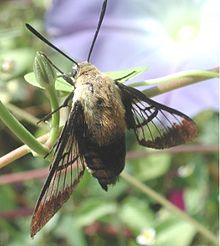Hemaris
| Hemaris | |
|---|---|
 |
|
| H. diffinis at Lake Junaluska, U.S. | |
| Scientific classification | |
| Kingdom: | Animalia |
| Phylum: | Arthropoda |
| Class: | Insecta |
| Order: | Lepidoptera |
| Family: | Sphingidae |
| Subfamily: | Macroglossinae |
| Tribe: | Dilophonotini |
| Genus: |
Hemaris Dalman, 1816 |
| species | |
|
See text |
|
| Synonyms | |
|
|
See text
Hemaris is a genus of sphinx moths in the subfamily Macroglossinae, which is native to the Holarctic. Their main host plants are herbs and shrubs of the teasel and honeysuckle families. Moths in genus Hemaris are known collectively as clearwing moths or hummingbird moths in the US and bee hawk-moths in Britain. The related Old World hummingbird moths, genus Macroglossum, are similar in appearance and habits. Both genera have tails that are provided with an expansile truncated tuft of hairs, but only Hemaris has the disc of the wings transparent, as these scales are dropped soon after eclosion.
The eggs are small, spherical, and pale glossy green in color. Host plants include shrub and vining honeysuckles and teasels.
The larvae are small, cylindrical, and covered in granules that often have small bristles. Most larvae are green, brown, and gray, but there are many color forms. All have a distinctive pale dorso-lateral longitudinal stripe from head to horn.
The pupa is enclosed in a loosely spun cocoon, and is glossy in most species. There is a prominent tubercle or hook alongside each eye. The cremaster of the chrysalis is large and flattened.
The imagoes, or adults, are small, diurnal moths that resemble bumblebees in shape. They are often mistaken for hummingbirds. The forewings are fully scaled, but in some species patches of scales are lost during the first flight, leaving a glassy hyaline area on each wing. The antennae are strongly clubbed in both sexes and each has a small, recurved hook at the end. The abdomen ends in a large fan of setae.
...
Wikipedia
